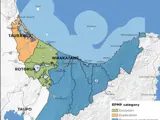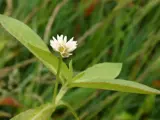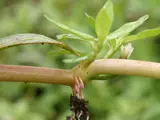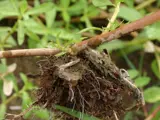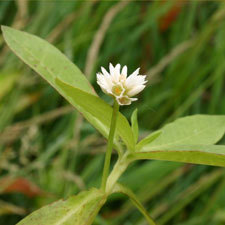 Alligator weed
Alligator weed
Common name: Alligator weed
Botanical name: Alternanthera philoxeroides
Management programme: Exclusion, Eradication, Progressive Containment
Alligator weed originates from Brazil, and was first discovered in New Zealand in Dargaville in 1906 where it is thought to have arrived as a hitchhiker in ship ballast water. It has since spread across the top of the North Island, including to the Bay of Plenty, by accidental movement of plant fragments through earthworks, fishing nets, and kumara farming.
Why is it a pest?
- Alligator weed is regarded as one of the world’s most damaging weeds as it can thrive in both aquatic and terrestrial environments, has a deep root system and is not easily killed by herbicide.
- As a terrestrial weed, alligator weed grows rapidly and can out-compete crops and pastures.
- It is known to be toxic to some livestock.
- As an aquatic weed, it can rapidly spread in streams and drainage canals, forming floating mats that trap sediments, increasing risk of flooding and obstructing water usage.
- Alligator weed is intolerant of frost and will disappear in the winter months in areas where frosts are present, but will grow back each summer from its rhizomes and roots.
- Alligator weed is highly invasive and can reshoot from small fragments of the stem sections. These fragments can be dispersed by water, soil movement, dumped vegetation, eel nets, livestock, boats (or trailers) or agricultural machinery.
- It has also been known to be spread by people where it can easily be mistaken for mukunu-wenna (Althernanthera sessilis), a plant used by some ethnicities as a vegetable.
Where is it found?
There are several known sites in the Bay of Plenty where alligator weed is being actively managed. These include the Rangitāiki River and terrestrial sites in Tauranga, Ōpōtiki and the East Cape area.
Areas at risk from alligator weed include freshwater and moderately brackish sites, moist banks, estuaries, pasture, cropping land, drains, ponds, lakes, rivers, and streams.
What does it look like?
- Alligator weed has rhizomes that creep along the ground or water surface forming dense floating mats or rafts.
- The dark green, elliptical shaped leaves are 5–10cm long with a distinct midrib. The waxy textured leaves are in opposite pairs, stalkless, and hairless.
- It stems are long, creeping, hollow, green, or red tinged stems.
- Stems and leaves are much smaller, rounder and more compact when growing in grazed pasture.
- The flowers that are present in New Zealand from December to February are single, white, and clover-like at the end of a longish upright stem. No seed is produced from the flowers in New Zealand.
What are the rules?
Exclusion
Exclusion pests are not known to be present or established in the Bay of Plenty region. The Bay of Plenty Regional Council is responsible for managing new incursions into the region. Action may be required from landowners or occupiers to support a control operation.
Eradication
Eradication pests are present in the region but are limited in their size or extent of infestation. The eradication of these organisms is a feasible and cost-effective solution. The Bay of Plenty Regional Council is responsible for their control or eradication from the region. Action may be required from landowners or occupiers to support a control operation.
Progressive Containment
Progressive Containment species are pests which the Council aims to prevent from spreading, reduce the distribution, or eradicate within parts of the region over time. Landowners or occupiers are responsible for the control of Progressive Containment species on their property. Council may enforce the control of these pest species.
Note: Council will maintain control and management of alligator weed. It is a very high risk plant and would not be feasible for occupiers to control.
How do you get rid of it?
Control of alligator weed is funded and carried out by Bay of Plenty Regional Council. We would like members of the public to let us know of any possible sightings of this plant.
Please do not attempt to control this plant, it is exceedingly difficult!
If you think you have found this plant, please let us know. Staff will always follow up possible finds of this plant and, if confirmed, we will work with you to control it.
Please avoid any transfer or dispersal of plant material. This is a highly invasive plant and requires special care when disposing of.
Images

